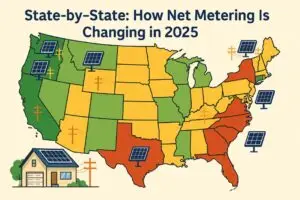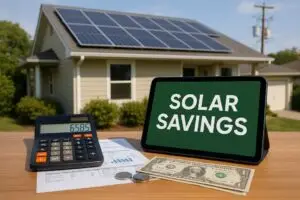2025 Net Metering Changes in the U.S.: What Every Homeowner Needs to Know Before Going Solar
Ever notice how 2025 net metering changes are making going solar feel less like an easy win? You’d slap a few panels on the roof, watch your meter spin backward, and dream about tiny utility bills. It was simple, at least on paper. But in 2025, things aren’t so straightforward anymore—and, honestly, if you don’t keep up, you might end up disappointed, or worse, scammed.
This year, net metering—the little-known rule that used to guarantee money back for your extra solar power—is going through a massive shake-up. The rules are changing everywhere, and they’re not changing the same way. What’s happening in Texas is totally different from California, Florida, or New York. And if you’ve ever tried reading your utility’s website, you know just how confusing this stuff can get.
Wait, What Is Net Metering Anyway?
Quick explainer for the uninitiated:
Net metering is basically the policy that says, “If your solar panels make more energy than you use, the extra goes back to the grid and your power company gives you credit for it.” Simple, right? Except… not anymore.
In 2025, some utilities are slashing how much they pay you for those extra electrons. Some are putting a cap on how much you can sell back. Others are quietly rolling out new rules that make the math a whole lot less fun. Why? Because, honestly, utilities say they need to cover costs, upgrade the grid, and keep things “fair” for everyone else. (Whether you buy that argument or not is up to you.)
So, Why Are People Worried?
Because solar isn’t as “set it and forget it” as it used to be. If you’re shopping for a solar system this year, or even just curious about your options, these new rules mean your payback time, your monthly savings, and even your decision to buy or lease could change overnight.
And here’s the kicker—most sales reps are still quoting old numbers. They’ll show you savings based on last year’s rules. Some are just as confused as everyone else. That’s why it’s crucial to look up the latest details yourself, and never sign anything without understanding your own utility’s net metering plan for 2025.
How 2025 Net Metering Changes Are Impacting Homeowners Nationwide
The 2025 net metering changes are shaking up the rules for solar savings in almost every U.S. state. Utilities and lawmakers are rewriting policies that used to guarantee strong credits for your extra solar power. What does this mean? Homeowners in every region need to pay attention—because these new net metering rules 2025 could change your payback time, your savings, and even whether going solar is the right move for you.
State-by-State: How Net Metering Is Changing in 2025
Honestly, the patchwork is wild. Every state has its own approach, and even city to city, things are different. Here’s a fast, no-nonsense rundown of what’s going on in some of the biggest solar states: Here’s how the 2025 net metering changes are unfolding in some of the biggest solar markets
California (NEM 3.0)
Remember when California was the “king of solar savings?”
Well, NEM 3.0 changed all that. Export rates (what you get paid for sending power back) are way lower now. If you don’t pair your system with a battery, your payback could be twice as long. It’s a totally new ballgame.
Texas
Texas has no official statewide net metering. Every utility sets its own rules. Some will buy your extra power; some won’t. Others cap it monthly. You really have to call around, and, frankly, it’s a bit of a headache.
Florida
There was a huge debate about gutting net metering in 2024. Right now, you can still get credit, but the politics are hot. Don’t be shocked if rates get slashed next year.
New York
The old net metering system is being swapped out for something called VDER (Value of Distributed Energy Resources). It’s complicated—your payout depends on where you live and what time you export. Not beginner-friendly, but still worth checking.
Arizona
Export rates drop every few months. They call it “resource comparison proxy,” which sounds like something a lawyer made up. Bottom line: you’ll get less money for your solar, but batteries can help offset that.
Illinois
In some areas, the cap for net metering has already been hit. That means new customers may not get full credit—some only get a wholesale rate. But there’s a bright spot: Illinois is leading the way in community solar for folks who can’t put panels on their roof.
And in places like New Jersey, Massachusetts, Colorado, North Carolina, and Nevada, the details get even weirder. The only real advice is: always look up your state and utility’s latest net metering rules before you buy.
What Does This Mean for Homeowners?
Let’s be real. If you’re thinking about 2025 net metering changes, solar in 2025, here’s what you have to know:
Your savings will probably be less than what your neighbor got a few years ago.
Not always, but it’s common—especially in California, Arizona, and any place that’s tweaked its export rates.Batteries aren’t just a “nice to have” anymore.
In a lot of states, pairing solar with storage is the only way to get real value. Sure, batteries cost more upfront, but you might make up the difference faster than you think.Community solar is on the rise.
Can’t put panels on your roof? Many states have “community solar” programs where you buy a share of a larger solar farm. It’s perfect if you rent, live in a condo, or just hate ladders.Don’t get scammed.
The solar boom has brought out some sketchy operators. Always check licenses, read recent reviews, and, honestly, if something sounds too good to be true, it probably is.Leasing vs buying?
With net metering changes, leasing often doesn’t pencil out unless you know you’re still getting strong export credits. Run the math both ways before you sign.
How to Calculate Your Solar Savings Now (Not Last Year’s Hype)
Forget those generic “save $1200 a year!” promises you see in ads. Here’s how to get a real number:
Get your current electric bill.
Figure out how much electricity you use in a typical month (kWh).Find your utility’s 2025 net metering export rate.
It might be buried on their site, but it’s worth the hunt.Ask installers for a custom estimate that uses today’s numbers.
If their quote uses “average” rates or old policies, ask for a revision.Factor in battery costs, if you’re adding one.
Some states even offer extra rebates for home battery systems.Check if there are any state solar rebates, tax credits, or time-of-use rate changes in your area.
Use a trusted online calculator.
Try the tools at Aurora Solar or EnergySage (they’re legit and free).
Pro tip: Don’t be afraid to compare at least three installer quotes. Some will push the latest policy details, others…not so much.
FAQs: The Questions Everyone Is Asking
Q: Is net metering even worth it anymore?
A: Depends where you live. In some states, yes, especially if you add a battery or use more power during the day. In others, the payback has gotten slower, but solar is still a hedge against rising energy prices.
Q: Why is everyone talking about the 2025 net metering changes?
A: Because these new rules are impacting solar payback times, savings, and even eligibility across the U.S. Understanding the 2025 net metering changes is crucial if you want to make a smart solar investment this year.
Q: What’s up with California’s NEM 3.0?
A: It’s a whole new system. Export rates are lower, so adding a battery is almost required for good savings. Solar is still solid, just not a “get rich quick” deal.
Q: Can I get the federal tax credit in 2025?
A: Yup. The 30% federal tax credit (ITC) is still live for residential systems. It’s a huge help, but always check with a tax pro.
Q: Is community solar a scam?
A: Nope! It’s real and getting bigger. Just check that the program is approved by your state or local utility.
Q: Should I wait to go solar?
A: Maybe. If you’re in a state about to cut net metering, or you want new tech (like ultra-cheap batteries), waiting could pay off. But with energy prices going up, waiting has its own risks.
Q: How do the 2025 Net Metering Changes affect my decision to go solar?
The 2025 Net Metering Changes are impacting homeowners across the U.S. in major ways. Before investing in solar, it’s essential to research how the 2025 Net Metering Changes are being implemented in your state and by your utility company. Many homeowners are discovering that the 2025 Net Metering Changes have shifted payback periods, savings projections, and even eligibility rules. If you want to make the smartest solar decision possible, always base your planning on the most up-to-date information about the 2025 Net Metering Changes.
A Few Real-Life Stories: Because Data Isn’t Everything
“My neighbor went solar in 2023, and his bills are way lower than mine. I signed up in late 2024, right after the new rules hit, and the credits aren’t what I hoped. Still, with a battery, I’m not worried about blackouts and my power bills are predictable. I just wish I’d signed up sooner!”
– Mike, San Diego
“We’re renters, so community solar was our only shot. We signed up through our utility’s site and get a discount on our bill every month. Easy, no hassle.”
– Trina & Alex, upstate NY
2025: State-by-State Net Metering Cheat Sheet
Here’s a quick peek at how some big states are handling net metering this year:
| State | Export Rate | Battery Bonus | Notes |
|---|---|---|---|
| California | Low (NEM 3.0) | Yes | Batteries = bigger win |
| Texas | Varies | Sometimes | Compare utility offers |
| Florida | Unchanged…for now | No | Might change in 2025 |
| Arizona | Falling | Yes | Export rate drops a lot |
| New York | VDER (complex) | Yes | Local programs vary |
| Illinois | Capped | Sometimes | Check utility details |
| Colorado | Moderate | Yes | Some local tweaks |
| Nevada | Low | Yes | Solar is still solid |
| Massachusetts | Changing | Yes | Policy under review |
| … | … | … | … |
Tip: Always look up your local utility’s exact rules!
Visual Aids You’ll Want To Add
Interactive map showing each state’s net metering policy (fast-loading, mobile-friendly).
Simple infographic: “How Net Metering Credits Work in 2025.”
Quick video explainer: Maybe even just a short YouTube embed explaining what changed.
Calculator widget so visitors can estimate their savings.
Community poll or quiz: “Is your state still net metering friendly?”
Final Take: Is Going Solar Still Worth It in 2025?
Short answer? For most people, yes—but you have to know the new rules, and you can’t just trust old advice. Solar is still one of the best ways to lock in your energy costs, boost your home’s value, and do your part for the planet.
But 2025 is not the “easy money” solar era. Get real numbers. Read the fine print. Ask tough questions. And please—don’t let anyone rush you into a contract before you’re sure.
👉 Learn more about savings opportunities at Affordable Solar and Energy Run Solar.
Thinking about solar, or already have it?
Drop your state in the comments below and let’s swap stories. Got more questions? Sign up for our free newsletter—real, honest updates with no spam, ever.
Don’t get left behind—stay ahead of the 2025 net metering changes and make sure your solar decision is based on the latest rules, not last year’s promises.


